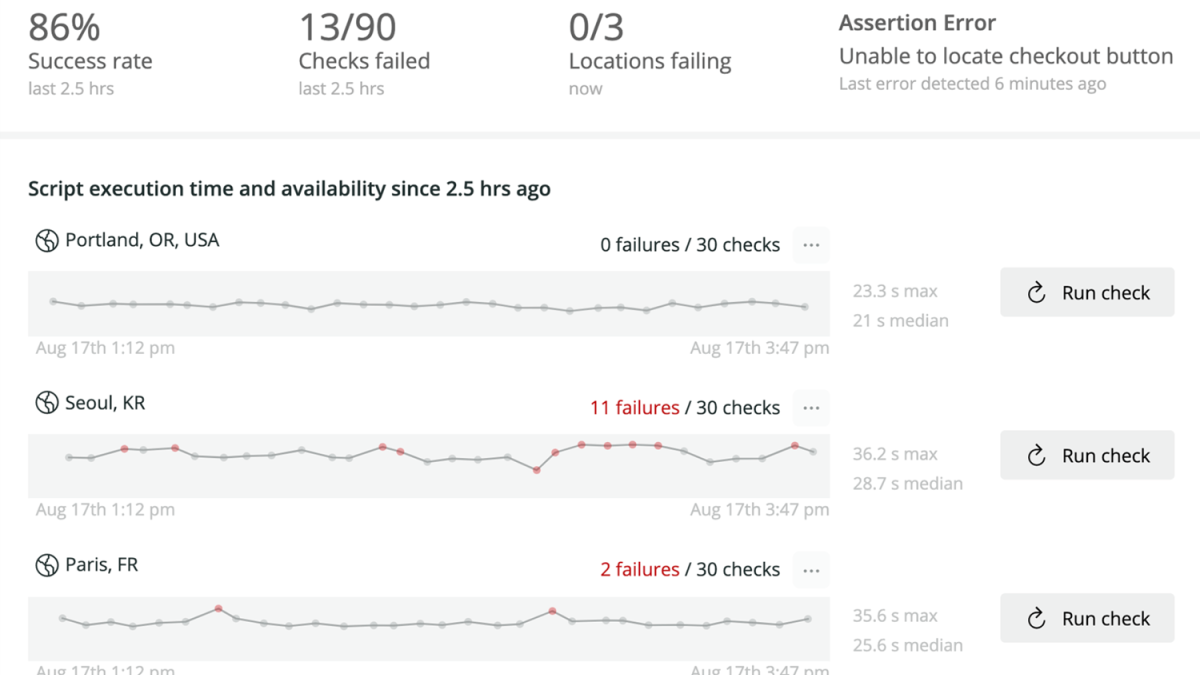
While real user monitoring gives you important insights about how users are interacting with your site, you don't get visibility into issues until they affect your users. Synthetic monitoring allows you to proactively test flows through your application so you can detect and fix performance issues quickly—and before they negatively impact your end users’ experience. Today, we announce the release of a next-generation runtime for synthetic monitoring, which includes updated features and functionalities to test user flows in your production environment and catch potential issues. With the launch of our next-generation synthetics runtime and support for private locations to come later this year, New Relic is committed to helping you improve your observability practice with updated services.
The new synthetics runtime makes browser version updates easier and more frequent. Our next-generation runtime supports the latest version of Chrome (version 100) and unlocks the testing of modern applications requiring newer Chrome versions. Additionally, we will continue to make updates to the browser versions to allow your synthetic monitors to run smoothly.
Additional capabilities include an improved synthetic runtime that uses the got Node request module, async/await support, and a custom timing library, allowing you to explore new synthetic monitoring use cases by reducing required monitor complexity. Here’s more information on the new features:
- Our scripted monitor types are customizable to cover additional protocols, which brings tremendous value. Additionally, our new scripted API runtime will use a got Node request module, although we will still be providing backwards compatibility to the deprecated request Node module. Now, our redesign of the runtime and consistent version updates make it even easier to track application performance. You’ll be able to test and meet your service level reliability initiatives without worrying about the robustness of your monitors.
- You can now use the NerdGraph API to manage all monitor types, secure credentials, and private locations. These new API endpoints can help simplify your workflow by reducing the number of API calls required for programmatic monitor management.
- We get it—writing asynchronous code in JavaScript is hard. We've added support for async/await syntax in all scripted monitor types, making it easier to manage your asynchronous code and scripted browser monitors.
- Now, you can more easily track the timing of various steps in your scripted API monitors. With the custom timing library, you can submit custom timing information that is tracked in the monitor result waterfall view. This new feature makes it much easier for you to progressively keep up with your monitors.
- If you are already using New Relic for synthetic monitoring, you're probably wondering how the changes will affect your current monitors. The latest update has been designed to minimize the number of changes you need to make to your monitor scripts when you upgrade. If you're not ready to make changes just yet, you can continue to use the current synthetic monitoring runtime.
You can update to the latest synthetic monitoring runtime with a simple dropdown.
How to migrate to the new runtime
If you’re already using synthetic monitoring, we recommend that you migrate to the new runtime. We are adding new IP addresses for our public locations, from where we run synthetics tests, to ensure the availability of an application.
To access the new runtime, you may need to change configurations to allow traffic from our new IP ranges, because any new monitors created or upgraded to use this runtime will use a new IP space. These new IP address ranges are now added to our public IP documentation.
After your traffic is configured appropriately, migrating to the new runtime is as easy as going to your existing monitors and navigating through a drop-down. Here's a quick video tutorial on how to do that:
Alternately, you can do this migration through the Nerdgraph API. To learn more, see the synthetic monitoring docs for runtime migration.
Próximos passos
Interested in upgrading your monitors? See the new runtime transition guide.
Want to start creating synthetic monitors today? Get started with synthetic monitoring. If you haven't already, sign up for New Relic One. Your free account includes 100 GB/month of free data ingest, one full-platform user, and unlimited free basic users.
As opiniões expressas neste blog são de responsabilidade do autor e não refletem necessariamente as opiniões da New Relic. Todas as soluções oferecidas pelo autor são específicas do ambiente e não fazem parte das soluções comerciais ou do suporte oferecido pela New Relic. Junte-se a nós exclusivamente no Explorers Hub ( discuss.newrelic.com ) para perguntas e suporte relacionados a esta postagem do blog. Este blog pode conter links para conteúdo de sites de terceiros. Ao fornecer esses links, a New Relic não adota, garante, aprova ou endossa as informações, visualizações ou produtos disponíveis em tais sites.



